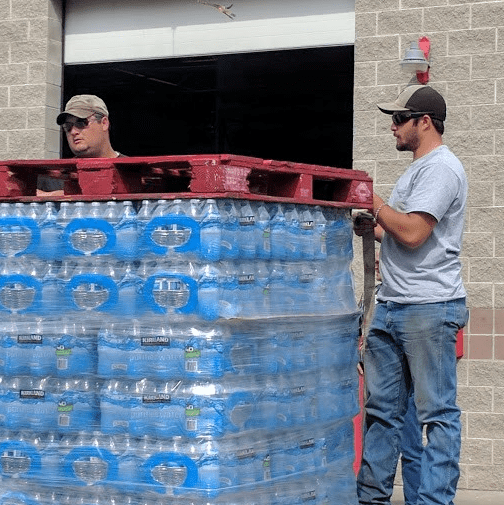MSU agriculture staff feel weight of Lodgepole fires, donate water to firefighters
Monday Aug. 7th, 2017
Some say Montana is a small town with long streets, and in the Big Sky State, the word “neighbor” is a verb. That notion may ring true, even at Montana universities.
When the nation’s largest fire erupted in late July in eastern Montana’s Garfield and Petroleum counties, the weight of the devastation reached two young men who work and manage MSU’s Red Bluff Ranch, just three counties west of the Lodgepole Fire Complex fire camp in Sand Springs.

JT Saunders, Red Bluff Ranch manager in the Department of Animal and Range Sciences in the College of Agriculture, was sitting in a baler, wondering what could possibly be done to help hundreds firefighters and the eastern Montana ranchers who were seeing their land, jobs and — in some harrowing cases — even livestock go up in flames.
After all, Saunders and his MSU ranch colleague Jace Solf, MSU research assistant and Winnett native, grew up in central Montana and personally know many Jordan, Mosby and Winnett families and ranches, either through summer work or high school sports.
“Central Montana is a whole beast of its own in terms of community, and it really hits home when you know the folks personally,” Saunders said. “The hardest part is wanting to do something but knowing there’s such a thing as being in the way. We wondered what could be helpful other than more people.”
A former rural volunteer firefighter himself, Saunders immediately thought of water. After phone calls to friends and fire relief efforts and a handful of emails to college administrators, Saunders and Solf secured modest university funds to purchase 9,000 bottles of water at a discounted rate of 7 cents apiece from the Bozeman Costco.
After a full day of work at the ranch, in the middle of the university’s haying season, Saunders and Solf loaded up five pallets — 11,000 pounds — of water at Costco, then drove 300 miles in five hours through the night, spent 40 minutes unloading at the Winnett Volunteer Rural Fire Department, turned around and drove back in time for work the next morning at MSU.
“It was a long night but nothing compared to what firefighters, producers and community members in central Montana are going through,” Saunders said.
Saunders knows first-hand what a community response to fire means. In 2006, when a wildlife enflamed Bear Trap Canyon near Red Bluff Ranch, one of several fires that affected MSU ranch land and livestock, neighbors and fellow MSU staff came to help, without needing a phone call.
“It’s all hands on deck during fire, you don’t wait for a call. You just show up,” Saunders said. “What I think most people don’t understand about rural ranch life is that fire just doesn’t take someone’s house, like in cities; people can still go back to a job the next day,” he said. “For a rancher, fire takes everything; their house, job, animals and, in some cases, generations of genetics and family history. They spend the whole year trying to keep these animals alive, and then you’re just humbled by the vulnerability to Mother Nature.”
The Lodgepole Fire Complex, according to the Bureau of Land Management’s Miles City Office, started on July 19 as four lightning-caused fires. Though livestock and property loss reports and data from the fires are still filing in, the BLM estimated the fire burned 270,723 acres and was 93 percent contained. The fires consumed mostly grazing land, with 80 percent to 100 percent of those lands experiencing a complete loss of grass, according to MSU Extension. BLM data also said 16 homes, numerous secondary structures, a significant amount of fencing and haystacks and 120 power poles were destroyed.
The fire prompted a statewide and national response from community organizations, nonprofits, banks, agribusinesses and corporations in the forms of money and supply donations, including animal feed, hay, labor, clothes, food, fencing supplies and land for grazing. The relief effort generated a popular hashtag on social media, #MontanaStrong.
“Our relationship with Montana’s agricultural community extends beyond research,” said Patrick Hatfield, Animal and Range Sciences department head. “As a land-grant, our connection with farmers and ranchers is personal, and their loss is our loss. Our hearts and empathy are with our friends in eastern Montana and I’m glad we were able to make a small donation that hopefully provided a bit of relief.”
While the long-term economic losses of the fires are still being evaluated, the ripple effect of the fire will have severe financial setbacks for years to come, Hatfield said. Gallatin County’s Farm Service Agency estimates the fencing repair across 1,400 miles at $15 million alone, and livestock respiratory damage from smoke inhalation creates serious risk of infection. Many ranchers will likely have to sell their livestock early; many of them are still searching for lost livestock, according to Hatfield.
Wildfire continues to be one of the nation’s largest and most devastating natural resource threats, especially for agricultural communities, Hatfield said.
“There’s likely no larger threat to our agricultural industry than fire caused by drought,” Hatfield said. “Wildfire is and will continue to be one of our largest challenges in states that are sustained by agricultural economies, like Montana, because devastation extends beyond the surface: Fire affects vegetation, food production, ecosystems, property loss and people’s lives.”
Hatfield added that a portion of the department’s research efforts are dedicated to effective fuel management and looking at fire as tool to manage ecosystems and stabilizing and reclaiming rangeland following fire devastation.
MSU Extension has compiled wildfire and drought resources, and the Northern Ag Network has organized a Web-based Montana Wildfire Relief page. The Montana Agriculture Fire and Drought Assistance Hotline is 1-844-515-1571.
| Tweet |